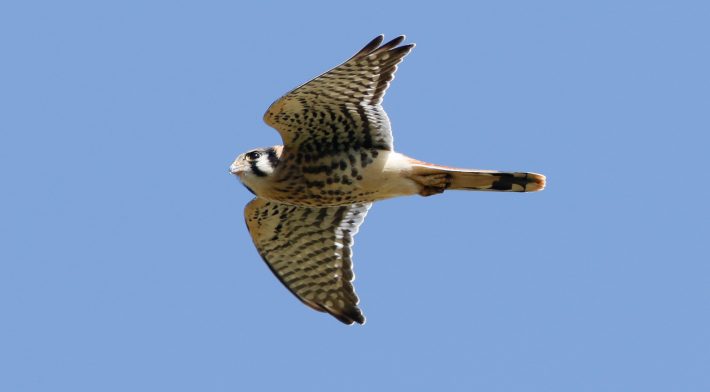“Frequent Fliers’’: Study finds long-distance dispersal trend in American kestrels
Boise State University press release.
Dispersal is ubiquitous in animal species, but tracking animals over large distances can be challenging. A new study published in the Journal of Animal Ecology uses bird banding and recovery data to estimate the frequency of long-distance dispersal in American kestrels, a migratory raptor that breeds throughout the western hemisphere.

The authors found that dispersal movements by kestrels are often of greater distances than can typically be detected within nest box study areas, and identified factors that are correlated with long-distance and short-distance dispersal movements.
Dispersal in American kestrels has been studied at numerous research sites in North America, and research has suggested that kestrels tend to remain a short distance from where they were hatched. However, these studies can be limited by study area boundaries, because researchers can often not locate birds that disperse outside of a study area, leading to uncertainty about the movements of those individuals.
A new study conducted by researchers from Boise State University examined kestrel dispersal throughout North America, using banding data collected by many researchers from 1961-2015 to capture dispersal at a large scale. “We aimed to understand the frequency and distances of kestrels dispersing more than 30 kilometers. We also sought to understand if factors related to global change, like temperature and land cover, influence dispersal distance,” said lead author on the research, Hanna McCaslin.
“Dispersal is the movement of an organism from where it was born to where it breeds, and is important because dispersal movements are critical for facilitating gene flow between populations, which can influence how well a species will be able to adapt to environmental change,” explained McCaslin.
McCaslin and coauthors Trevor Caughlin and Julie Heath wanted to understand the frequency of long-distance dispersal movement and the factors that may be shaping those dispersal movements. They expected that long-distance dispersal may be more common than suggested by studies conducted at smaller spatial scales, and may be influenced by factors associated with global environmental change, like temperature and landcover.
“Banding data and other long-term data sets are powerful tools for studying populations at large scales, and we wanted to understand kestrel dispersal at a larger scale than what we are able to capture with local studies,” said McCaslin. Across North America, researchers and permitted bird banders have been collecting information on kestrels for decades and submitting it to the Bird Banding Laboratory, which is affiliated with the United States Geological Survey.

The team discovered that dispersal of more than 30 kilometers (long-distance dispersal) was influenced by temperature and migratory strategy, and made up nearly half of the dispersal accounted for in the study. They also found that shorter dispersal movements were linked to sex and population density.
“Our findings indicate that long-distance dispersal is relatively common, and suggest that long-distance and short-distance dispersal may be distinct processes in kestrels. This result is particularly important because it indicates that environmental change may influence the two differently, which may have implications for how kestrels adapt to global change,” said McCaslin.
This research was supported by the Department of Biological Sciences and Raptor Research Center at Boise State University, and a Department of Defense Strategic Environmental Research and Development Program (SERDP) grant awarded to Heath.
McCaslin hopes that the team’s discovery will continue to shape future research, and also prove useful for Heath’s ongoing research project called Full Cycle Phenology, a large, collaborative project using a year-round, comparative approach to further understand migratory connectivity, population change, and the impacts of climate change on the American kestrel and other landbirds. “I hope that these results will encourage other researchers to examine long-distance dispersal in their study organisms, because it may give us new insight into how species might adapt to global change.”
You can read the article for free (for a limited time) here:
https://besjournals.onlinelibrary.wiley.com/doi/10.1111/1365-2656.13272
Media contact:
Hanna McCaslin, hanna.mccaslin@colostate.edu
Julie Heath, Professor of Biology, julieheath@boisestate.edu
Like what we stand for?
Support our mission and help develop the next generation of ecologists by donating to the British Ecological Society.